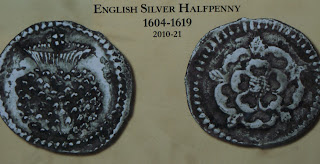Largest Coin -
 |
| French Ecu 1702 |
At slightly less than 2" in diameter, this ecu of King Louis XIV was a French "sliver dollar."
Smallest Coin -
 |
| English Silver Halfpenny 1604-1619 |
In 17th-century England, even the lowest denomination was made from silver. This tiny, pea-sized coin is only 3/8".
Highest Denomination -
 |
| Brazilian 20,000 Reis 1724 |
Worth 20,000 reis, this Brazilian gold coin contains more than 1 1/2 ounces of pure gold. The most valuable circulating coin during the period, one of these would have paid four months' salary of a journeyman artisan in Virginia right before the Revolutionary War.
Lowest Denomination -
 |
| English Farthing 1699 |
The English farthing was worth 1/4 of a penny. It was highly useful for small, every day purchases.
Prettiest Coin -
 |
| Dutch Gold Ducaton 1687 |
This 1687 Dutch "Rider" ducaton is made of gold. It was struck with specially engraved and polished dies, resulting in a stunning piece with mirror-like surfaces.
Ugliest Coin -
 |
| Bolivian 4 Reales 1677 |
Almost all Spanish colonial "cobs" were crudely made and irregular. This coin has an insertion of a silver plug, meant to bring its weight up to par.
First "Greenback" -
Today's "greenbacks" trace their origins to the £6 note issued by New Jersey in 1757. It was the first to have a back side printed in green ink.
First $1 Bill -
 |
| Maryland $1 Note 1767 |
Even though the denominations were the same, colonial American paper money always was worth less than the equivalent amounts in gold and silver were worth in England.
We stayed until the museum closed at 7:00 pm. I don't think we saw everything. :}
Needless to say, we were ready to call it a day!
T was sitting nicely, getting his picture taken outside the visitor center on our way to the parking lot...
when all of a sudden, he impulsively turned around to play in the water!
He thought that was so funny!!
I did, too. ;o)
 |
| T loves his papa...and vice versa! |












No comments:
Post a Comment